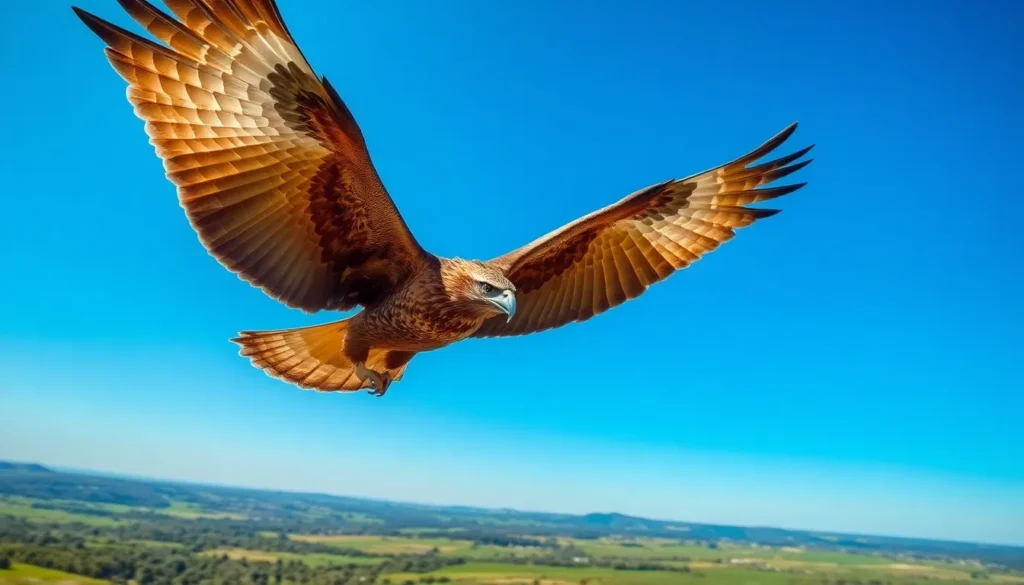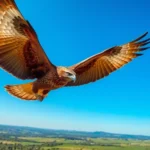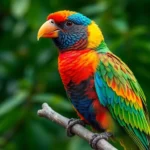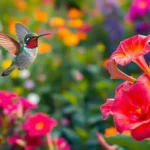We’ve all witnessed that breathtaking moment when a bird takes flight – wings spreading wide as it effortlessly soars through the sky. There’s something magical about watching these feathered creatures defy gravity and navigate the air currents with such grace and precision.
Understanding bird flight mechanics isn’t just fascinating from a scientific perspective – it’s also crucial for photographers, birdwatchers, and nature enthusiasts who want to capture or observe these aerial displays. From the powerful wingbeats of eagles to the delicate flutter of hummingbirds, each species has developed unique flight patterns and techniques.
Whether you’re looking to improve your bird photography skills, deepen your appreciation for avian behavior, or simply satisfy your curiosity about how birds master the art of flight, we’ll explore the incredible industry of airborne birds and unlock the secrets behind their remarkable abilities.
What Makes Birds in Flight So Captivating
Birds in flight create visual poetry through their effortless movement across open skies. Movement patterns reveal intricate aerodynamic principles that evolved over millions of years. Graceful wingbeats synchronize with wind currents to produce stunning aerial displays.
Wing mechanics demonstrate nature’s engineering mastery through precise feather positioning and muscle coordination. Different species exhibit unique flight characteristics that distinguish their aerial signatures. Eagles employ thermal soaring techniques that conserve energy during extended flights. Hummingbirds generate figure-eight wing patterns that enable hover capabilities and rapid directional changes.
Color variations become more pronounced during flight as sunlight illuminates feather structures from multiple angles. Iridescent plumage creates shifting rainbows that change with viewing perspective. Light filtering through wing membranes produces translucent effects that enhance visual drama.
Speed variations add ever-changing elements to bird flight observations. Peregrine falcons reach diving speeds exceeding 240 mph during hunting sequences. Swallows perform intricate aerial maneuvers at moderate speeds while catching insects. Geese maintain steady formations during migration journeys spanning thousands of miles.
Environmental interactions showcase birds’ adaptive responses to atmospheric conditions. Wind patterns influence flight paths and create opportunities for energy conservation. Storm systems force birds to adjust altitudes and modify navigation strategies. Industry features like coastlines and mountain ranges serve as natural highways for migrating species.
Behavioral complexity emerges through social flight formations and communication systems. Flocking patterns demonstrate collective decision making and predator avoidance strategies. Courtship flights display elaborate aerial choreography designed to attract mates. Territorial displays involve aggressive flying maneuvers that establish dominance hierarchies.
Human observers connect emotionally with birds in flight because these moments represent ultimate freedom and grace. Photography captures split-second wing positions that reveal hidden beauty invisible to naked eyes. Birdwatching provides peaceful meditation opportunities while observing natural flight behaviors. Nature documentaries bring remote bird flight phenomena into accessible viewing experiences.
The Science Behind Bird Flight Mechanics

Bird flight mechanics represent one of nature’s most sophisticated engineering achievements, combining complex anatomical structures with precise aerodynamic principles. We examine the fundamental forces and adaptations that enable birds to master three-dimensional movement through air.
Wing Structure and Aerodynamics
Wings function as biological airfoils through their curved upper surface and flatter lower surface configuration. This asymmetrical design creates differential air pressure, generating lift when air moves faster over the top surface than underneath.
Primary flight feathers at wingtips control direction and provide thrust during the power stroke. Secondary feathers along the wing’s trailing edge maintain smooth airflow and prevent turbulence. Covert feathers create a seamless surface that reduces drag while maintaining structural integrity.
Bird bones contain hollow spaces that reduce weight by up to 50% compared to solid bones of similar strength. Flight muscles comprise 15-25% of total body weight in most flying species, with the pectoralis major powering the downstroke and supracoracoideus controlling the upstroke.
Wing loading varies significantly across species:
| Species Type | Wing Loading (N/m²) | Flight Characteristics |
|---|---|---|
| Albatross | 40-60 | Efficient soaring |
| Hawk | 25-35 | Maneuverable hunting |
| Hummingbird | 12-25 | Hovering capability |
| Swallow | 8-15 | Agile insect catching |
Different Flight Patterns and Techniques
Soaring flight exploits thermal updrafts and wind currents to minimize energy expenditure. Large birds like eagles and vultures extend their wings and adjust feather angles to ride air columns for hours without flapping.
Flapping flight involves continuous wing beats that generate both lift and thrust simultaneously. Small songbirds use rapid wingbeats ranging from 200-800 beats per minute, while larger waterfowl maintain 150-250 beats per minute during sustained flight.
Hovering requires specialized wing mechanics where birds rotate their wings in figure-eight patterns. Hummingbirds achieve stationary flight through 50-80 wingbeats per second, generating lift during both upstroke and downstroke phases.
Formation flying reduces energy costs by 10-15% through strategic positioning in wingtip vortices. Migrating birds like geese rotate leadership positions to distribute the aerodynamic workload across the flock.
Diving techniques involve wing folding and body streamlining to achieve maximum velocity. Peregrine falcons reach speeds exceeding 240 mph during hunting dives by tucking wings close to their bodies and adjusting tail feathers for steering control.
Essential Equipment for Photographing Birds in Flight

Successfully capturing birds in flight demands specialized equipment that complements the complex aerodynamics and unpredictable movements we’ve explored. Professional-grade cameras and telephoto lenses form the foundation for sharp, detailed images of these aerial subjects.
Camera Bodies and Lenses
Camera bodies designed for wildlife photography feature fast autofocus systems and high burst rates that track birds through their flight patterns. Mirrorless cameras like the Sony Alpha 7R V deliver 10 frames per second with continuous autofocus, while DSLRs such as the Canon EOS-1D X Mark III achieve 16 frames per second for capturing rapid wing movements.
Modern camera sensors perform exceptionally in challenging lighting conditions that birds create during dawn and dusk flights. Full-frame sensors capture more light than crop sensors, producing cleaner images at ISO 3200-6400 when photographing birds against bright skies or in shadowed environments.
Telephoto lenses between 400mm-800mm provide the reach necessary for maintaining safe distances from birds while filling the frame. Prime lenses like the Canon RF 800mm f/11 IS STM offer superior image quality and faster autofocus than zoom alternatives. Zoom lenses such as the Nikon AF-S 200-500mm f/5.6E provide flexibility for tracking birds as they move closer or farther away.
Image stabilization technology compensates for camera shake during handheld shooting of birds in flight. Optical stabilization in lenses works independently of camera movement, while in-body stabilization systems coordinate with lens stabilization for enhanced shake reduction up to 5 stops.
Settings and Configuration Tips
Shutter priority mode gives photographers control over motion blur while the camera selects appropriate apertures for proper exposure. Shutter speeds of 1/1000 second freeze most bird movements, while speeds of 1/2000 second capture sharp images of fast-flying species like peregrine falcons during hunting dives.
Continuous autofocus modes track moving subjects across the frame as birds change direction during flight. Canon’s AI Servo AF and Nikon’s AF-C maintain focus on birds even when obstacles briefly interrupt the focus point.
Aperture settings between f/5.6-f/8 provide sufficient depth of field to keep birds sharp while maintaining fast shutter speeds. Wider apertures like f/4 isolate birds from cluttered backgrounds but require precise focus on the bird’s eye for professional results.
ISO settings between 800-3200 maintain image quality while enabling fast shutter speeds in various lighting conditions. Modern cameras handle ISO 6400 effectively when photographing birds during golden hour or overcast conditions.
Burst mode captures multiple frames per second, increasing the probability of capturing birds with wings in optimal positions. High-speed continuous shooting modes record 8-20 frames per second depending on camera specifications and memory card write speeds.
Back-button focus separates autofocus activation from the shutter button, allowing photographers to track birds continuously without refocusing when recomposing shots. Custom function buttons programmed for focus tracking modes enable quick adjustments as bird behavior changes during flight sessions.
Best Locations for Bird in Flight Photography

Strategic location selection dramatically impacts our success when capturing birds in flight photography. We focus on environments where birds exhibit predictable flight patterns and frequent activity.
Coastal Areas and Wetlands
Coastal environments provide exceptional opportunities for photographing birds in flight due to consistent updrafts and abundant food sources. We find seabirds like pelicans, gulls, and cormorants performing dramatic fishing dives and graceful gliding patterns along shorelines. Salt marshes and tidal flats attract thousands of shorebirds during feeding periods, creating ever-changing flight compositions as birds move between roosting and foraging areas.
Wetland ecosystems support diverse bird populations year-round, making them prime locations for flight photography. Great blue herons, egrets, and ibises demonstrate elegant flight patterns as they navigate between feeding spots and nesting colonies. Prairie potholes and inland marshes host waterfowl like mallards, pintails, and teal, which offer exciting takeoff and landing sequences during dawn and dusk periods.
Timing our visits with tidal changes maximizes photographic opportunities in coastal wetlands. Birds concentrate their feeding activities during low tide when exposed mudflats reveal invertebrates and small fish. High tide periods force birds into flight as they seek alternative feeding locations or return to roosting sites.
Migration Routes and Timing
Major flyways concentrate millions of birds into predictable corridors, creating unparalleled opportunities for flight photography. The Atlantic Flyway channels birds along the eastern seaboard from breeding grounds in Canada and Alaska to wintering areas in Central and South America. We position ourselves at bottleneck locations like Cape May, New Jersey, and Hawk Mountain, Pennsylvania, where geography funnels migrating raptors into concentrated flight streams.
Spring migration peaks occur between March and May, while fall migration extends from August through November across most North American routes. Raptors demonstrate the most dramatic flight displays during September and October when thermal conditions optimize soaring behavior. Warblers and other songbirds migrate primarily at night but concentrate at coastal and lakefront areas during dawn hours.
Weather patterns significantly influence migration timing and intensity. Cold fronts trigger massive movements as birds ride favorable tailwinds, while warm, stable conditions can delay migration for days. We monitor weather forecasts and radar imagery to predict peak migration days that produce exceptional flight photography opportunities.
Geographic features like mountain ridges, river valleys, and lake shores create natural migration highways. The Rio Grande Valley in Texas funnels neotropical migrants between Mexico and North America, while the Great Lakes shoreline guides waterfowl and raptors along predictable routes. Point Pelee, Ontario, and Magee Marsh, Ohio, represent critical stopover sites where exhausted migrants rest and feed before continuing their journeys.
Techniques for Capturing Sharp Bird in Flight Images

Sharp bird in flight photography demands mastering exact camera techniques that compensate for rapid movement and unpredictable flight patterns. These technical approaches transform challenging aerial subjects into stunning photographic achievements.
Focus Tracking and Continuous Autofocus
Continuous autofocus (AI Servo on Canon or AF-C on Nikon/Sony) serves as our primary tool for maintaining sharp focus on moving birds. This mode constantly adjusts focus as subjects move through the frame, tracking birds across various distances and flight paths. Modern cameras offer multiple autofocus point configurations, with 65-point, 153-point, and even 693-point systems providing extensive coverage across the viewfinder.
Subject detection autofocus revolutionizes bird photography by automatically recognizing and tracking avian subjects. Canon’s Animal Detection AF, Sony’s Real-time Eye AF for animals, and Nikon’s Subject Detection identify birds within the frame and maintain focus on critical areas like the head and eye. These systems work effectively even when birds change direction or partially leave the frame.
Custom autofocus sensitivity settings prevent focus hunting when birds fly behind branches or other obstacles. Setting sensitivity to responsive or high prevents the camera from immediately refocusing when temporary obstructions appear. Zone AF and ever-changing area AF modes offer optimal balance between precision and flexibility, using clusters of focus points that adapt to erratic flight movements.
Back button focus separates focusing from the shutter release, providing complete control over when the camera locks focus. Assigning focus activation to the AF-ON button allows us to track birds continuously while capturing multiple frames at the optimal moment. This technique proves essential when photographing birds that hover, dive, or execute sudden directional changes.
Shutter Speed and Motion Blur
Shutter speeds of 1/1000s or faster freeze wing motion completely for most bird species, creating tack-sharp images that showcase individual feather details. Large raptors like eagles and hawks require minimum speeds of 1/800s, while smaller songbirds demand 1/1250s to eliminate motion blur from rapid wingbeats. Hummingbirds present the greatest challenge, requiring shutter speeds exceeding 1/2000s to capture their wings without blur.
Strategic motion blur adds dynamism to bird photography when applied selectively to wing tips or background elements. Shutter speeds between 1/250s and 1/500s create artistic blur in wing extremities while maintaining sharp focus on the bird’s body and head. This technique works particularly well with soaring birds that exhibit slower, more predictable wing movements.
Panning techniques at slower shutter speeds (1/60s to 1/250s) produce striking images with sharp subjects against blurred backgrounds. Following the bird’s flight path while maintaining consistent camera movement creates smooth background streaks that emphasize speed and motion. Success requires steady horizontal movement and precise timing to match the bird’s velocity.
Image stabilization systems compensate for camera shake at slower shutter speeds, extending the range of usable settings for handheld shooting. Modern 5-axis stabilization provides up to 6.5 stops of compensation, allowing sharp captures at speeds previously requiring tripod support. Disabling stabilization during high-speed panning prevents system interference with intentional camera movement.
Burst mode capabilities ranging from 10 to 30 frames per second ensure we capture peak action moments during rapid flight sequences. High-speed continuous shooting increases the probability of obtaining perfectly timed shots when birds execute quick maneuvers, dive attacks, or landing approaches. Buffer capacity determines sustainable burst duration, with professional cameras maintaining full speed for 200+ RAW frames.
Common Challenges and How to Overcome Them
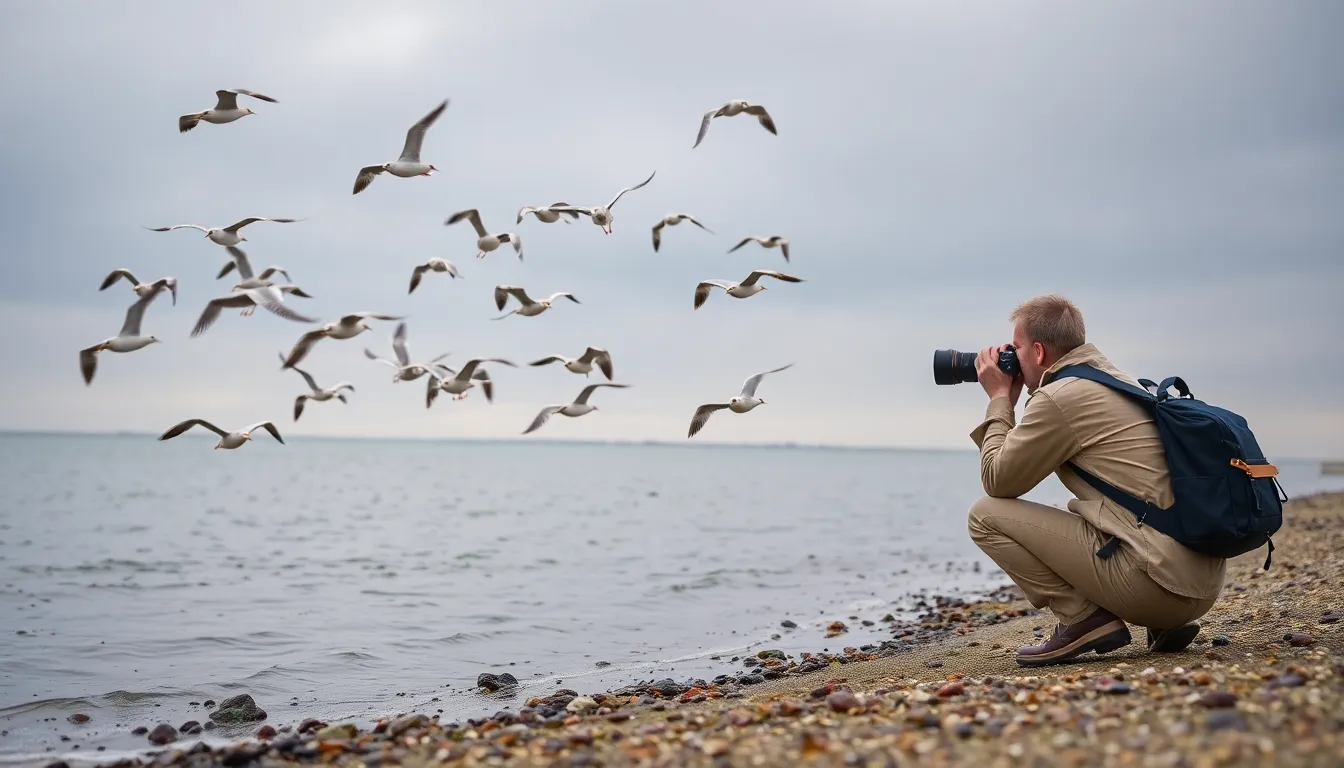
Bird in flight photography presents unique obstacles that separate amateur attempts from professional results. Mastering these challenges transforms frustrating experiences into rewarding photographic achievements.
Lighting Conditions and Weather
Overcast skies create diffused lighting that flattens bird details and reduces contrast in flight images. We compensate by increasing ISO values between 800-1600 while maintaining shutter speeds above 1/1000s to preserve image quality. Golden hour lighting produces warm tones but creates harsh shadows on bird undersides during overhead flight paths.
Backlighting situations occur frequently when birds fly between photographers and bright sky backgrounds. Exposure compensation of +1 to +2 stops prevents silhouetting while maintaining detail in feather textures. Fill flash techniques work effectively for close subjects within 30 feet but prove ineffective for distant soaring birds.
Strong winds affect camera stability and bird flight patterns simultaneously. Tripods with fluid heads provide steadier platforms in gusty conditions exceeding 15 mph. Birds alter their flight trajectories during windy weather, often flying lower and following terrain features rather than straight paths.
Rain and snow create atmospheric moisture that reduces image sharpness and contrast. Lens hoods protect front elements from precipitation while UV filters prevent water droplets from adhering to expensive telephoto glass. Weather sealing becomes essential for camera bodies during extended outdoor sessions in challenging conditions.
Predicting Bird Behavior
Feeding patterns dictate the most productive photography windows throughout each day. Shore birds concentrate along water edges during low tide periods, creating predictable flight corridors between feeding and roosting areas. Raptors hunt most actively during morning thermals between 9-11 AM when rising air currents support effortless soaring.
Seasonal migration timing varies by species and geographic location but follows consistent patterns. Waterfowl migrations peak during October and March in North American flyways, while songbird movements occur primarily during April-May and August-September periods. Weather fronts trigger massive movement events that concentrate thousands of birds into narrow time windows.
Territory defense behaviors create opportunities for ever-changing flight photography during breeding seasons. Male red winged blackbirds patrol marsh boundaries with aggressive flight displays, while hawks engage in territorial disputes near nesting sites. These interactions produce dramatic aerial encounters lasting 30-60 seconds.
Roosting sites generate predictable morning and evening flight activity as birds travel between sleeping and feeding areas. Large communal roosts like starling murmurations create spectacular flight formations 30 minutes before sunset. Dawn departures from roosts occur gradually over 45-90 minute periods as different species leave at species exact times.
Disturbance responses follow predictable patterns based on bird species and human proximity. Waterfowl flush distances range from 50-200 yards depending on hunting pressure in exact areas, while songbirds typically react to movement within 20-30 feet. Understanding these comfort zones allows photographers to position themselves optimally without causing unnecessary stress to wildlife subjects.
Post-Processing Tips for Bird in Flight Photos
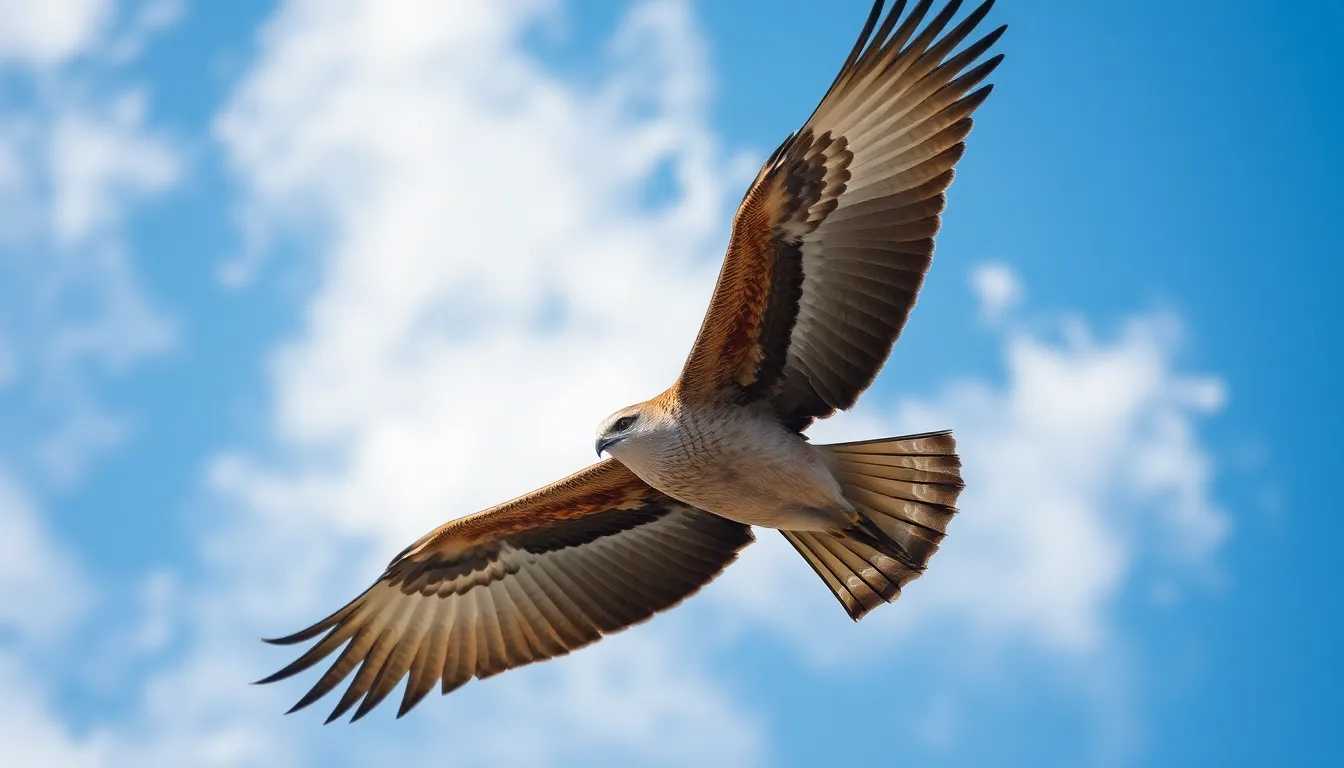
Post-processing transforms raw bird flight captures into compelling images that showcase the grace and power of airborne subjects. Digital enhancement techniques allow us to correct exposure issues, sharpen details, and emphasize the ever-changing movement captured during flight sequences.
Exposure and Color Correction
RAW file processing provides maximum flexibility when adjusting exposure values for bird in flight images. We recommend starting with global exposure corrections to balance highlights and shadows, particularly important when dealing with bright sky backgrounds and darker bird subjects. Highlight recovery tools restore detail in overexposed areas like white feathers or bright wing tips, while shadow lifting reveals intricate feather patterns in underexposed regions.
Color temperature adjustments enhance the natural tones of bird plumage and environmental elements. Golden hour captures often benefit from slight warming adjustments, while overcast day images may require cooler temperature settings to maintain natural appearance. Vibrance increases color saturation selectively without oversaturating skin tones or existing vibrant colors, making it ideal for improving subtle feather coloration.
Sharpening and Detail Enhancement
Unsharp masking techniques target exact frequency ranges to enhance feather detail without creating artifacts. We apply different sharpening amounts based on the subject distance and original image sharpness. Close-up bird portraits require gentler sharpening settings (Amount: 50-80, Radius: 0.8-1.2, Threshold: 2-4), while distant subjects benefit from more aggressive settings (Amount: 100-150, Radius: 1.0-1.5, Threshold: 0-2).
Structure and clarity adjustments add midtone contrast that emphasizes feather texture and wing detail. These tools work particularly well on bird in flight images captured in soft lighting conditions. Masking techniques allow us to apply sharpening selectively to the bird while avoiding background noise enhancement.
Background Management
Background simplification draws attention to the primary subject by reducing distracting elements. Graduated filters darken busy backgrounds while maintaining proper exposure on the bird subject. Radial filters create subtle vignettes that naturally guide the viewer’s eye toward the flying bird.
Color grading techniques harmonize background tones with the bird’s natural coloration. Desaturating background colors while maintaining vibrant bird plumage creates visual separation between subject and environment. Split-toning adds complementary colors to highlights and shadows, improving the overall mood of bird flight imagery.
Motion Enhancement Techniques
Selective blur applications emphasize speed and movement in static images. We apply motion blur to wingtips and trailing feathers while keeping the head and body sharp, creating a sense of ever-changing movement. Background blur enhancement separates the bird from its environment, particularly effective when the original depth of field appears insufficient.
Contrast masking techniques highlight the bird’s form against complex backgrounds. Local adjustments increase contrast on the bird’s silhouette while softening background elements. These selective edits create dramatic separation that emphasizes the bird’s powerful presence in flight.
Batch Processing Workflows
Preset development streamlines the editing process for large collections of bird flight images. We create custom presets that address common issues like exposure compensation for bright skies, noise reduction for high ISO captures, and standard sharpening settings for different focal lengths.
Synchronization tools apply consistent adjustments across multiple images from the same shooting session. This approach maintains visual coherence when creating series or portfolios of bird in flight photography. Metadata organization helps identify the most successful captures for detailed individual processing.
Conclusion
We’ve explored the remarkable industry of birds in flight from every angle—the science behind their extraordinary abilities the art of capturing their grace through photography and the deep connection these moments create with nature itself.
Armed with proper equipment techniques and timing you’re now ready to embark on your own journey photographing these aerial masters. Remember that every flight tells a story and each image you capture preserves a moment of pure natural poetry.
The sky awaits with endless opportunities to witness and document the breathtaking beauty of birds in their element. Whether you’re drawn to the power of raptors or the delicate dance of songbirds your camera can freeze these fleeting moments of freedom for generations to appreciate.
Frequently Asked Questions
What makes bird flight so captivating to observe?
Bird flight represents visual poetry in motion, combining effortless movement with intricate aerodynamic principles. The graceful soaring, unique wing patterns, and color variations of feathers catching light create mesmerizing displays. Each species exhibits distinct flight characteristics, from eagles’ thermal soaring to hummingbirds’ precision hovering, making every observation a unique experience that symbolizes freedom and natural beauty.
How do birds generate lift and stay airborne?
Birds generate lift through their wings functioning as biological airfoils with asymmetrical designs. The curved upper surface creates lower air pressure compared to the flatter bottom surface, producing upward lift. Primary, secondary, and covert feathers work together to control airflow, while wing loading affects flight characteristics. This sophisticated engineering allows birds to manipulate air currents efficiently.
What are the main types of bird flight patterns?
The five primary flight patterns include soaring (using thermal updrafts like eagles), flapping (rapid wingbeats like songbirds), hovering (stationary flight like hummingbirds), formation flying (energy-efficient group flight during migration), and diving (high-speed hunting dives like peregrine falcons). Each pattern serves specific purposes related to feeding, migration, or hunting strategies.
What camera equipment is best for photographing birds in flight?
Professional-grade cameras with fast autofocus systems, high burst rates, and telephoto lenses (300-600mm) are essential. Key features include continuous autofocus, image stabilization, and modern sensors for low-light performance. Camera bodies with advanced subject detection and back-button focus capabilities significantly improve tracking success. Fast shutter speeds and burst mode are crucial for capturing sharp images.
Where are the best locations for bird flight photography?
Coastal areas and wetlands offer prime opportunities due to predictable flight patterns and abundant food sources. Migration routes along major flyways concentrate millions of birds during peak seasons. Strategic locations include shorelines during tidal changes, thermal-generating landscapes for raptors, and geographic features that create natural migration highways. Timing visits with seasonal migrations maximizes photography opportunities.
What camera settings work best for bird in flight photography?
Use shutter priority mode with speeds of 1/1000s or faster for smaller birds, 1/500s for larger species. Set continuous autofocus (AI Servo/AF-C) with custom sensitivity settings. Use wider apertures (f/5.6-f/8) for sufficient depth of field while maintaining fast shutter speeds. Adjust ISO as needed for proper exposure, and utilize burst mode for capturing peak action moments.
How can I overcome common challenges in bird flight photography?
Address lighting challenges by adjusting exposure compensation and using spot metering for backlit subjects. Combat strong winds by increasing shutter speeds and using image stabilization. Study bird behavior patterns, feeding times, and territorial habits to predict flight activity. Position yourself strategically near roosting sites or feeding areas while maintaining respectful distances to avoid disturbing wildlife.
What post-processing techniques enhance bird flight photos?
Focus on exposure and color correction to balance highlights and shadows. Apply targeted sharpening to enhance feather details and eye clarity. Use background blur or cleanup techniques to isolate subjects. Employ motion enhancement methods like selective sharpening along flight paths. Batch processing workflows ensure consistency across large collections while maintaining natural-looking results that emphasize the bird’s dynamic movement.

